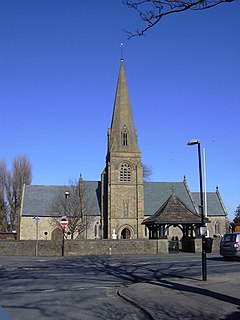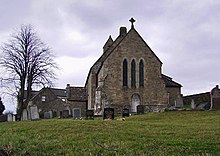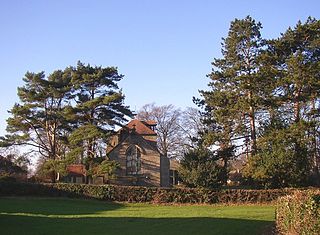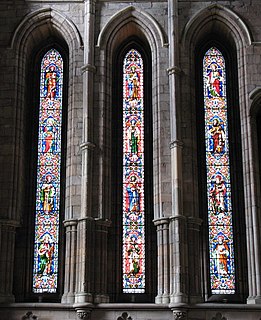
St Paul's Church is in Scotforth, a suburb of Lancaster, Lancashire, England. It is recorded in the National Heritage List for England as a designated Grade II listed building. It is an active Anglican parish church in the deanery of Lancaster, the archdeaconry of Lancaster and Morecambe, and the diocese of Blackburn. The architectural historian Nikolaus Pevsner described it as a "strange building" and "an anachronism, almost beyond belief".

St Mark's Church is in Buncer Lane, in the former parish of Witton, Blackburn, Lancashire, England. It is an inactive Anglican church in the deanery of Blackburn with Darwen, the archdeaconry of Blackburn, and the diocese of Blackburn, and is now up for sale. Originally a separate parish, in 2005 it combined with the parish of St Luke with St Philip to form the Parish of Christ the King. The church is recorded in the National Heritage List for England as a designated Grade II* listed building.

Christ Church is in the village of Glasson, Lancashire, England. It is an active Anglican parish church in the deanery of Lancaster and Morecambe, the archdeaconry of Lancaster, and the diocese of Blackburn. Its benefice is combined with those of St Michael, Cockerham, and St Luke, Winmarleigh. The church is recorded in the National Heritage List for England as a designated Grade II listed building.

Holy Trinity Church, Morecambe, or Morecambe Parish Church, is in Church Street, Morecambe, Lancashire, England. It is the Anglican parish church of Morecambe, in the deanery of Lancaster, the archdeaconry of Lancaster and the diocese of Blackburn. The church is recorded in the National Heritage List for England as a designated Grade II listed building.

St Nicholas Church is in the village of Wrea Green, Lancashire, England. It is an active Anglican parish church in the deanery of Kirkham, the archdeaconry of Lancaster and the diocese of Blackburn. Its benefice is combined with those of St Matthew, Ballam and St Michael, Weeton. The church is recorded in the National Heritage List for England as a designated Grade II listed building.

Holy Trinity Church is in the village of Wray, Lancashire, England. It is an active Anglican parish church in the deanery of Tunstall, the archdeaconry of Lancaster, and the diocese of Blackburn. Its benefice is united with those of St Peter, Leck, St Wilfrid, Melling, St John, Tunstall, St James the Less, Tatham, and the Good Shepherd, Tatham Fells, Lowgill.

St Cuthbert's Church is in the village of Over Kellet, Lancashire, England. It is an active Anglican parish church in the deanery of Tunstall, the archdeaconry of Lancaster, and the diocese of Blackburn. The church is recorded in the National Heritage List for England as a designated Grade II* listed building.

St Barnabas' Church is in Regent Road, Morecambe, Lancashire, England. It is an active Anglican parish church in the deanery of Lancaster and Morecambe, the archdeaconry of Lancaster, and the diocese of Blackburn.

St Margaret's Church is in Lonsdale Road, Halliwell, Bolton, Greater Manchester, England. It is an active Anglican parish church in the deanery of Bolton, the archdeaconry of Bolton, and the diocese of Manchester. Its benefice is united with that of Christ Church, Heaton.

St Mary Magdalene's Church is in Ribbleton Avenue, Ribbleton, Preston, Lancashire, England. It is an active Anglican parish church in the deanery of Preston, the archdeaconry of Lancaster, and the diocese of Blackburn. Its benefice is united with that of The Church of the Ascension, Ribbleton.

St Thomas' Church is in Caunce Street, Blackpool, Lancashire, England. It is an active Anglican parish church in the Deanery of Blackpool, the Archdeaconry of Lancaster and the Diocese of Blackburn.






















